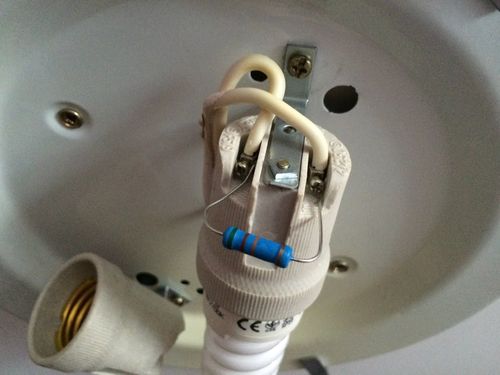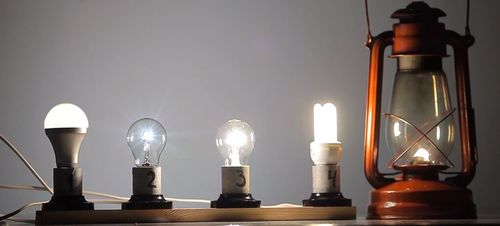The switched off LED lamp blinks. Ways to eliminate the problem. Variable and constant
Flickering of LEDs during their operation can be caused by several reasons.
To correctly determine on your own why it is blinking LED lamp when the light is off, you need to familiarize yourself with the design features of such a lighting source.
Key components of any standard LED lighting fixtures are usually presented:

- diffuser flask performing mechanical protection LEDs and evenly distributing luminous flux;
- LEDs or semiconductor, light-generating elements;
- printed circuit board for connecting diodes;
- a radiator housing that provides sufficient heat dissipation during lamp operation;
- driver electronic unit, generating voltage to power the LEDs, enclosed in a protective housing;
- basement part.
Any version of an LED lamp has certain advantages and disadvantages, but such models, according to experts, are much better than conventional filament lamps. tungsten lamps in terms of energy consumption and the quality of the resulting lighting.
Reasons for flickering of switched off light bulbs
Why do LED lights blink when the switch is off?
If the LEDs flicker characteristically when turned off, then you need to remember the negative consequences of such flickering observed over a long period of time.
Namely:
- the general well-being of people worsens;
- the phases of night sleep are upset;
- performance decreases;
- There is eye fatigue and severe headaches.
Among other things, the service life of the lighting source and components, which, as a rule, cannot be replaced, are reduced. Flickering can be caused by the following situations:
- low quality lighting fixtures and inconsistency in the power of the LED lamp;
- violations during the laying of electrical communications, including incorrect installation switch;
- the presence in the lighting system of LEDs and switches with neon or LED backlighting;
- close location LED lighting to devices and instruments capable of generating large electromagnetic fields;
- long service life and a general decrease in lighting quality.
When the lights are off, energy-saving lighting sources LED type Most often they flicker when the power supply is poor or there are significant changes in voltage.
Troubleshooting Methods
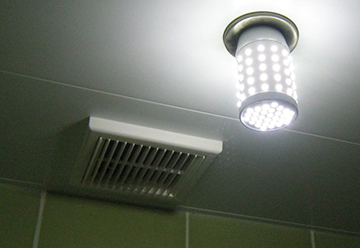 The most common causes of blinking include any error when installing the switch and setting it to a zero break, which is completely unacceptable with such a lighting system.
The most common causes of blinking include any error when installing the switch and setting it to a zero break, which is completely unacceptable with such a lighting system.
The shutdown process in this case does not stop the operation of the LED lamp, but causes it to blink characteristically.
Switch backlight problem
The most common cause of flickering in the off position is a problem with the backlit switch, which is a small LED that lights up when the key is in the off position. An interruption in the circuit causes electricity to flow to the LED.
Standard ways to solve the problem if the LED lamp flickers are as follows:
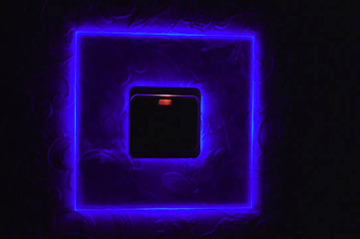
- disconnection LED wires from the main electrical circuit;
- removing the indicator light and installing a simple switch;
- connecting an ordinary lighting lamp to an electrical circuit, which will reduce the voltage that charges the capacitor;
- connecting a resistor with a power of 2W and a resistance of 50 kOhm in distribution box or next to the socket, when connecting it is used terminal block, and the resistor is insulated using a heat-shrinkable tube.
The most popular option is to connect the backlight using a separate wire. The disadvantage of this method is the presence additional connection wires
Resistor installation
Elimination of LED blinking is often done by installing a shunt resistance in the form of a resistor in the electrical circuit. This method helps eliminate turning off the backlight or replacing switching devices.
A resistor is installed in the power distribution area, and to prevent overheating and subsequent fire, the device is insulated with a special heat-shrinkable tube. The optimal option is to connect the resistor in parallel by soldering. On final stage the resulting soldering is placed in a special box.
Correction of electrical wiring
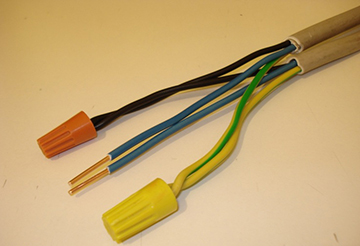 Violations committed during the electrical installation process are very often associated with an erroneous connection neutral wire, which causes the phase to flow into the lighting even after turning off.
Violations committed during the electrical installation process are very often associated with an erroneous connection neutral wire, which causes the phase to flow into the lighting even after turning off.
In this case, the mounted capacitor is charged almost constantly, and such an error can be correctly corrected only by reconnecting the phase.
Determine correctly phase wire You can use a tester or a special probe. You may also need to install protective equipment in the form of an RCD.
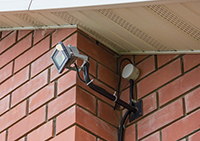 With the help of a spotlight you can create excellent street lighting. to the network yourself and what is needed for this? Read carefully.
With the help of a spotlight you can create excellent street lighting. to the network yourself and what is needed for this? Read carefully.
You will find everything about the features of taking readings from electricity meters.
How to seal an electricity meter and who should do it? You will find the answers to these questions.
Other factors that cause flicker
Quite often, the owner of LED lighting is faced with situations in which such devices emit short-term flashes even in the off position.
A similar phenomenon can occur when the light source is too close to electrical wiring, emitting a relatively powerful and stable electric field, gradually increasing the amount of energy inside the driver capacitor. When maximum voltage values are reached, a flash of light appears.
Flickering of a standard LED lamp can also occur if the installed lighting device is not intended for the specific loads of the light controller and if the driver is completely incompatible with the control circuit used. In this case, the driver or the lighting fixture itself is replaced to match optimal values voltage.
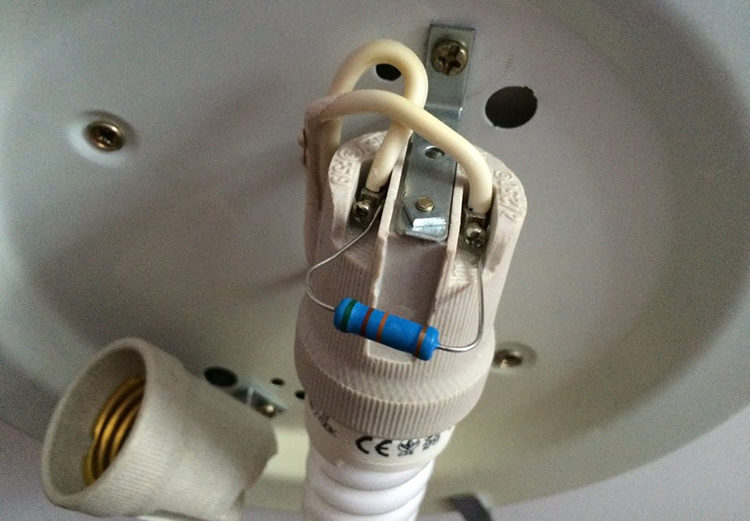
Installing a shunt resistor directly into the socket
In addition to improper connection or installation, the cause of blinking may be a defect in the products used, so experts recommend purchasing only high-quality certified devices produced by reliable and already tested well-known companies and manufacturers.
If necessary, it is possible to install a transformer that can reliably provide the required parameters of the LED.
LED flickering during operation
LEDs can flicker during operation, and this problem, as a rule, is not noticeable visually. If, after turning on, the LEDs light up, but after a few seconds they go out, then the main reason can be considered a failure of the trigger mechanism, which cannot cope with the conversion or supply functions electric current. In this case, it is recommended to completely replace the starter.

The reasons for the periodic blinking of LED lamps can be presented:
- too low voltage level in the incoming electrical network;
- malfunction of the starting system;
- excessive fluctuations and sudden voltage surges.
With time energy saving light bulbs may acquire malfunctions in microcircuits, which also causes incorrect operation of lighting devices.
Deviations from optimal conditions operation significantly reduce the service life of LEDs and quality characteristics lighting.
Thus, you can prevent harmful flickering of LEDs if you use high-quality and fully operational lighting devices, and also follow all the rules when connecting to a direct electric current network.
Video on the topic
LED lamps are increasingly appearing in our apartments. They are economical, environmentally friendly, durable. And they are relatively high price pays for itself within a short period of time. But they also have one drawback - sometimes they can blink. Why this happens and how to fix it will be discussed in this article.
It arises from the fact that most of the electrical networks we use operate on alternating current with a frequency of 50 Hz. AND led lamps, “pulsate” with the same frequency. Thanks to the inertia of vision, we do not see these pulsations, and the light flux seems even to us. But on a subconscious level this can lead to negative consequences: from psychological discomfort to serious problems with vision.
For evaluation, the ripple coefficient is used, which is expressed as a percentage. Its value should not exceed 10% so as not to cause harm to humans. Be sure to read about.
Causes of blinking:
- Manufacturing defect. The production process is not yet very cheap. And some unscrupulous manufacturers try to save on components. This most often leads to the lamp flickering.
- Frequent and large power surges. If this indicator is significantly exceeded, flickering is inevitable. Therefore, it is worth measuring the voltage in your home network and troubleshooting.
- High frequency interference coming from some types of household appliances. Such interference can create microwaves, wireless speakers and cameras, equipment satellite dishes, radiotelephones with a frequency of 2.4 or 5 GHz. and a number of others.
- Light bulbs in the backlights of switches that work in the dark. Since the circuit in which the backlight is turned on remains closed even after it is turned off, this can also cause the LED lamp to blink.
The video shows 4 lamps in comparison. The author demonstrates the operation of LED lamps in comparison. After watching the video you will receive necessary set knowledge to choose a lamp.
Let's look at the most common causes of blinking.
If the lamp blinks when turned on
If immediately after turning on the LED lamp you see that it goes out after a few seconds, and then starts working again, then the problem is in the lamp starting mechanism. The starter that regulates the operation is usually very reliably built into the design of the LED lamp. So you are unlikely to be able to replace it yourself unless you are a specialist. It is best to exchange what you bought for another in the store.
Light bulbs are everyday goods that can be exchanged if any defects are found in them. And some manufacturers generally provide a guarantee on lamps for a period of several years. Therefore, keep the receipts for the LED lamps you purchase so that if you discover a manufacturing defect, you can quickly and easily exchange them.
If the lamp blinks even during its continuous operation, then possible reason There may be large (more than 5%) deviations in voltage. In this case, it is worth checking and eliminating these faults by calling specialists. After all, such deviations in the power supply of your home negatively affect not only the operation of LED light bulbs, but also all electrical equipment.
If the lamp blinks when turned off
The main factor influencing the flickering of an LED lamp after it is turned off is a problem in the electrical network. Let the specialists servicing your home deal with major problems, but you can reduce the impact of minor problems yourself.
Check the connections in the electrical wiring and, if possible, install a new one instead of the old one. Notice the switch that has a flickering LED light connected to it. The wire that is connected to the break in the switch should not be connected to zero, otherwise, due to constant recharging, the lamp will continue to blink. The photo shows the correct diagram for connecting an LED lamp to the network. The only caveat is the LED in the switch, which results from using a backlit switch, which we will discuss below.
If you have sources of high-frequency interference in your apartment that are included in the general electrical network, then you should use voltage stabilizers with surge protectors.
All work with the power supply of the apartment should be carried out only when there is no voltage in the network. Turn it off on the panel when introducing wires into the apartment. And when working, use only serviceable tools with electrical insulation.
Using an Illuminated Switch
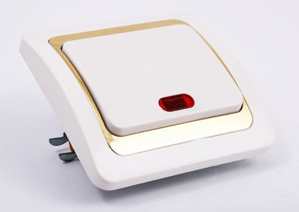 We will separately talk about how a switch with an indicator affects the operation of LED light bulbs. These switches use a small LED to operate. The voltage for its operation causes the capacitor of the LED lamp to constantly charge, which leads to flickering. There are several ways to solve this problem.
We will separately talk about how a switch with an indicator affects the operation of LED light bulbs. These switches use a small LED to operate. The voltage for its operation causes the capacitor of the LED lamp to constantly charge, which leads to flickering. There are several ways to solve this problem.
- If there are two or more lamps in the chandelier, then replace one of them with a simple lamp incandescent, it will absorb “excess” voltage. This method has another advantage. As you know, LED lights do not light up instantly, but gradually. An incandescent lamp will provide light immediately. In addition, mixing light with ordinary and LED light bulb will be more comfortable for the eyes.
- Connect the switch LED to the network separate wire, directly, and not through a switch. True, then it will always burn, and not just in the dark. The increase in electricity consumption from its operation will not be so significant, but it will solve the problem
- Connect a resistor with the following characteristics to the network: voltage 220 V, power 2 W, resistance 50 kOhm. It will also absorb “extra” voltage. This perfect option for luminaires where only one LED bulb is used.
How to see flicker
To determine the pulsation coefficient, tests are carried out on special equipment. But you can see the “blinking” (identify low-quality products) in simple ways.
For example, pointing the camera mobile phone on the LED light bulb during operation. The more blinking, the higher the pulsation coefficient. And if you take a photo without a flash, the pulsation will appear in the form of dark stripes.
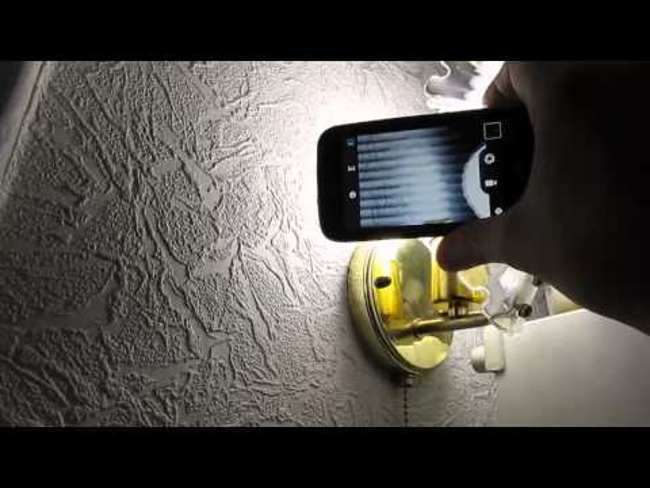
If you don't have a camera at hand, use a regular pencil or pen. Take it by one end and, pointing it at the light bulb, quickly move it like the blades of a fan. “Several” visible pencils instead of one indicate that the lamp has a poor ripple factor.
What to do when a low quality lamp is detected? Correct solution— replace with a high-quality one with a good pulsation coefficient. An alternative is to use it indoors with minimal presence of people: corridors, bathroom, etc.
Summing up
So, blinking LED lamps is a completely solvable problem. Choose lamps from well-known manufacturers who guarantee the quality of their products. The methods described above will help you cope with blinking at home.
LEDs today are considered perhaps the most reliable and stable light sources: the “work” of a semiconductor crystal is determined only by the presence of electric current, voltage drops have little effect on it, since the device operates through a converter, and so on. Why the LED lamp blinks with all these parameters is a controversial question.
Flickering when turned on
If the LED lamp is on, it's bad. Semiconductor crystals—actually diodes—are powered by direct current, so it is impossible to simply plug in a diode device of this kind into the network. The entire strips with diodes are connected to some kind of converter, and spotlight They are equipped with a “personal” converter - an electronic driver.
The efficiency of the latter is largely determined by its design, and this affects the cost. The LED lamp flickers, as a rule, when budget option drivers - through a capacitor. The driver with stabilization in more expensive models does not flicker when turned on.
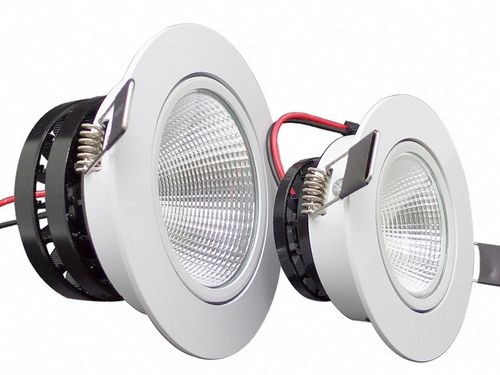
How does this happen, and how does blinking a working light source affect the condition?
Why does the turned on LED light blink?
There are quite specific GOST standards for the flicker frequency of lighting devices, depending on their type and purpose. It is absolutely impossible to violate these recommendations if you want to maintain your health, especially your eyesight.
The fact is that the human brain is capable of perceiving pulsations of up to 300 Hz per second, but vision no longer detects these vibrations. Therefore the light fluorescent lamp and the sun is perceived by the eyes as identical and bright, which is not true. sunlight does not blink, and neither the brain nor the eyes get tired. The more pronounced the pulsation and the lower the frequency it occurs, the stronger the effect on the brain. At the same time, vision deteriorates, headaches, dizziness, possibly nausea and fainting begin. After just half an hour of reading or other work in this light, it causes severe eye fatigue and a desire to immediately get out into the fresh air.
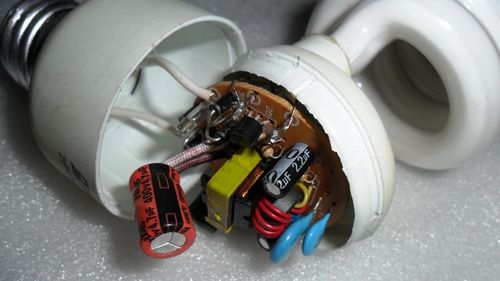
According to GOST, it is prohibited to write or read in lighting with pulsation above 20%. This is how a fluorescent and switched-on LED with a low-quality driver flickers. Such devices can be used in lighting non-residential premises- entrances, elevators, corridors, but in no case in residential or work premises.
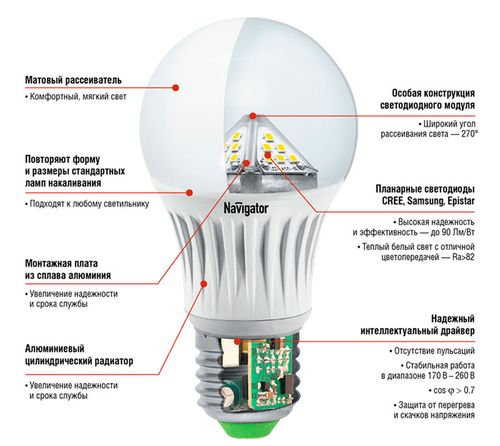
What to do in such cases?
- The most effective, but the hard way– installation of a new driver. However, such alteration requires experience and specific knowledge.
- The simplest and most accessible method is to connect an additional capacitor for stabilization. In this way, voltage surges will be smoothed out more reliably, and the lamp will stop flickering after switching on.
- If we are talking about a chandelier, you can install one common driver for all LEDs. This will significantly save costs and time.
Why does the LED lamp turn off blink?
The normal state of the wiring and the quality of the electric current are such that the phenomenon when the lamp flashes not when turned on, but when turned off, is the most common thing. This is not so bad for your health, but it still causes irritation and anxiety.
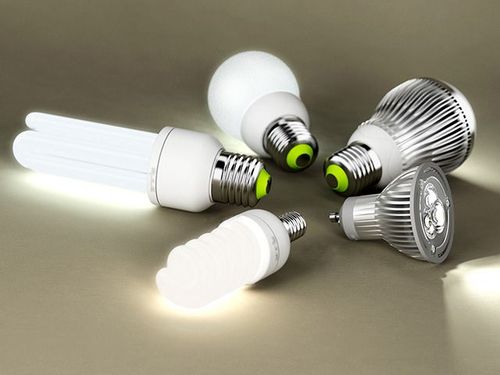
The reasons for the lamp blinking after switching off are more varied.
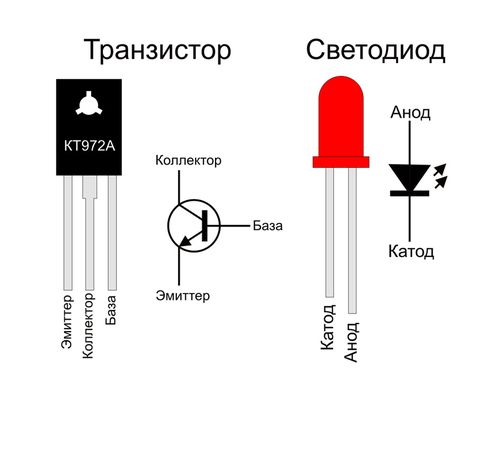
- Driver power may not match technical parameters lamp
- If the voltage drops are too great, then even a high-quality driver will not cope with its task. Therefore, it is completely pointless to install energy-saving devices on old wiring.
- The reason may be an ordinary marriage. If it is detected within warranty period, and, as a rule, this is exactly what happens, the device can be replaced.
- Most often, devices flicker when the lights are off, if a backlight is installed on the switch. In this case, when turned off, the lamp goes out, but the indicator on the switch still requires power. This current is very low, the driver cannot start with it. However, over time, even such a weak current gradually charges the capacitor of the switched-off lamp and at some point turns it on. Since there is no supply current, the lamp immediately goes out, and the accumulation process on the capacitor begins anew.
- Another option typical modern apartments– the presence of equipment that creates high-frequency interference near the light source. The radiation may well cause the lamp to flicker.
Ways to eliminate the problem
What should I do if the LED lamp flashes when the light is off? You can do it differently.
When using LEDs as primary lighting sources, you may encounter such actual problem, like a periodic pulsation of light. Why does the LED lamp blink when turned on? This is due to the peculiarity of the LED matrix, which, unlike an ordinary electric lamp incandescent, skips D.C. only one way.
The light from an ordinary incandescent filament also pulsates, but due to the fact that for such a lamp it does not matter in which direction the electrons move, the flickering frequency corresponds to the carrier frequency of the alternating current in the network (50 Hz) and is not visible to our eyes. In addition, due to the heating of the spiral, the pulsation amplitude luminous flux insignificant.
An LED emits light only in a strictly defined direction of current, and an arbitrary change in voltage immediately causes a change in brightness.
The types of blinking can be divided into two types:
- low frequency (up to 50 Hz);
- high frequency (above 50 Hz).
The reasons can also be divided into three main groups:
- low voltage in the network is insufficient for full operation of the LED lamp power circuit;
- constant voltage drops in the network;
- malfunction or design features power schemes.
The alternating voltage in the network changes its amplitude in the form of a sinusoid with a frequency of 50 times per second. When passing through the LED, only a positive or negative half-wave will generate a glow in the matrix.
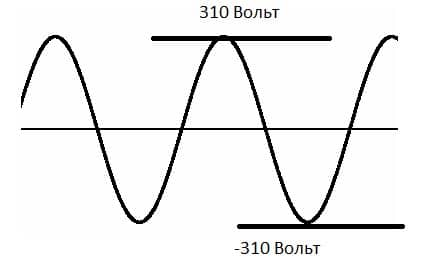
If the LED lamp blinks, the manufacturer may have saved a lot on the power supply. In the most budget models, a single-bridge (half-wave) rectifier is sometimes used, which converts AC voltage to the required constant.
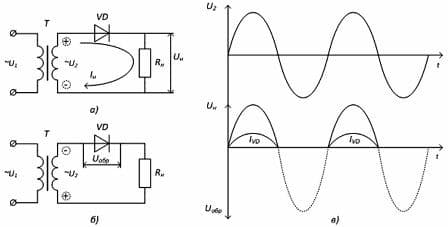
After the diode bridge, part of the oscillations of the opposite phase is cut off, and to reduce ripple, a capacitor is included in the electrical circuit. With this scheme, we clearly see the pulsation of light with a frequency of twenty-five times per second.
If flashing LED lamp in the on state and after installing a normal rectifier bridge in the power circuit, the problem is in the smoothing capacitor.

At maximum amplitude it accumulates charge, at minimum it returns it to the load. The average amplitude of the output voltage decreases, but the ripple becomes significantly less. If the capacity is insufficient, its resource is not enough to power the LEDs, the brightness of which changes with each half-wave. By sanitary standards pulsation of the light flux should not exceed 10% of the nominal intensity.
How to get rid of blinking LED lamps in these cases?
Resoldering a diode rectifier bridge and a capacitor of larger capacity will help to make lighting without pulsation.
The third reason why light can pulsate even in the highest quality lamps is voltage drops in the network itself. Effective mains voltage 310V (nominal 220V). Often, especially in evening time, when residents turn on a powerful load, the voltage can drop to 190-180 V, which leads to flickering of the light sources.
Why do LED lamps from branded manufacturers blink?
At low voltage in the network, even with sufficient capacitor capacity, flickering may appear, since due to a decrease in amplitude the capacitor simply will not have time to recharge.
Such power surges are occasional, but if they cause discomfort, installing a voltage stabilizer can help.
If all the problems have been resolved, but the LED lamps still blink when turned on, check the contacts on the socket and switch. Perhaps the oxide film simply worsens the contact at the junction.
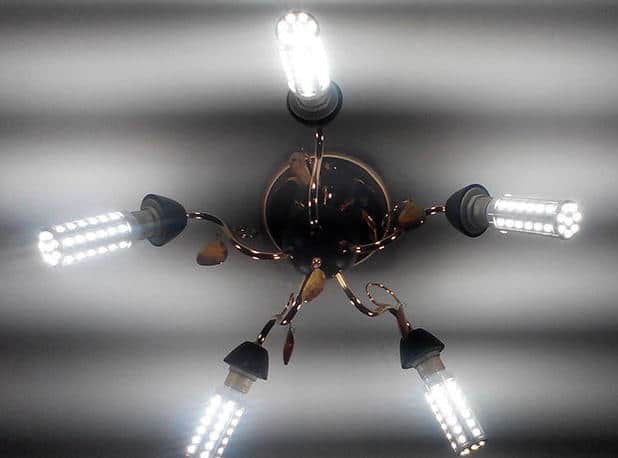
It is extremely rare that not the entire light bulb blinks, but only part of the LEDs. Why does the LED blink when neighboring crystals are shining normally? This problem occurs if several types of crystals with different power ratings were used when assembling the matrix. Unfortunately, it is not possible to fight this; most likely, some of the LEDs will soon simply fail.
The blinking of LED lamps with a low frequency, visible to the eye, is immediately detected and the only question is to find the cause.
High frequency LED flicker
A more serious problem is the flickering of LED lamps when turned on at a frequency of 100 Hz (one hundred times per second). Our visual organs do not recognize such pulsation, but the brain is able to easily perceive vibrations with a maximum frequency of up to three hundred times per second. Such a light installed in a hallway or bathroom will not cause problems. But reading or performing precise work in such lighting will cause increased fatigue, including headaches.
How to recognize such a pulsation if the eye does not see it? Take a ballpoint pen or a pencil and quickly wave it in front of the light bulb. If the pencil “breaks up” into separate fragments when moving quickly, there is pulsation.
Another way to establish such a pulsation is to look at the lamp through the built-in camera of a mobile phone.
The presence of dark stripes confirms high-frequency pulsation.
Why do LED lamps flicker when turned on?
The most likely reason is the relatively low quality of the LED matrix itself. Even with a “classical” power supply circuit, output voltage ripple is inevitable. High-quality LEDs in a certain voltage range have almost the same luminescence intensity, due to which any ripple is eliminated.
With “problematic” matrices, even a voltage drop of 0.5V already generates a noticeable change in brightness. In some cases, the current situation can be slightly improved by increasing the capacitor capacity, but it is still not recommended to install such light in living rooms.
If you detect a blinking LED lamp, do not leave everything to chance. In the worst case, it can cause vision problems over time. If possible, it is better to immediately return the light bulb to the seller. If this is not possible, take the time to eliminate all shortcomings.
Hello dear readers of my website website. And today, I would like to talk about why LED lamps blink.
Agree that such a factor as lighting of houses is very important, and every person wants to make their home as light and bright as possible. But if you put a lot of light bulbs in your home, then you will receive receipts for electricity with very large amounts. Of course, there is a way out in this situation, since now it is very wide choose energy saving lamps. And the most economical lamps are now considered LED.
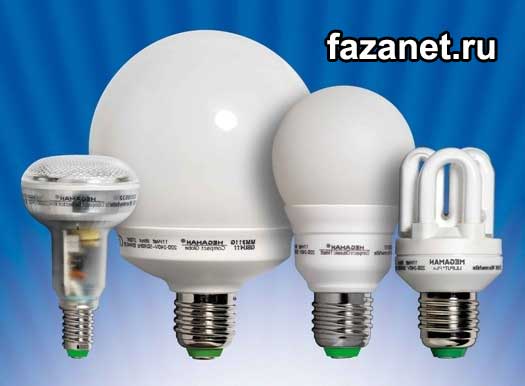
Many people have long switched to this type of lamp. I also installed LED lamps almost everywhere in my home. And I noticed that there was much more light from them, and I began to pay less for electricity. But not everything is as good as it seems at first glance. Many people, when installing such lamps, encounter a problem such as flickering of the lamps when they are on, and also when they are off.
And this flicker is not only annoying, but also very harmful to your eyes. So what to do in such a situation? How to get rid of this flicker? If you are also facing the same situation, then you should not panic.
Now we will look at the most common cases of flickering, and also talk about how to get rid of it.
Why does a switched off LED lamp blink?
Let's look at the most basic reasons for this phenomenon.
1. You have an illuminated switch in your house.
The thing is, when you turn off the switch, electrical circuit the light bulb opens. But the electrical backlight circuit remains closed, and in this case, small impulses will pass through the light bulb. They will be the reason why the light bulb glows.
This problem can be solved very easily. You can simply take and replace the backlit switch with a regular one without backlight. But not everyone will want to do this, since an illuminated switch is much easier to find in the dark, and many installed them precisely for this purpose.
There is another solution. It is necessary to connect a resistor with a power of 2 W and a nominal resistance of 50 kOhm in parallel to the lamp. You can connect the resistor in the branch box, or if you have a spotlight that is built into the ceiling, you can do this directly on the lamp itself.
Watch the video to see how this is done.
In addition to the resistor, you can also connect a paper capacitor. You just need to choose it with a good voltage reserve so that it works longer. A capacitor with a voltage of 660 V and which has a capacity of 0.1 µF is perfect for this purpose. It connects in the same way as a resistor.
Another useful video.
But I want to warn you that if you do not have enough experience in the field of electricity, then it would be best to contact a specialist.
2. You need to check whether your lamp is connected correctly.
The fact is that many “specialists”, so to speak, do everything quick hand, and do not check the correct connection. In the lighting circuit, the phase must be supplied to the switch, that is, it must break. And the zero should be fed directly to the lamp base.
You can check this with a voltage indicator on the switch. Just be sure to turn off the power before opening the switch. Remove the cover from the switch, apply voltage to it, and touch the terminal contacts with the voltage indicator in the off state. If there is voltage there, then everything is correct, if there is no voltage, then the circuit is not correct.
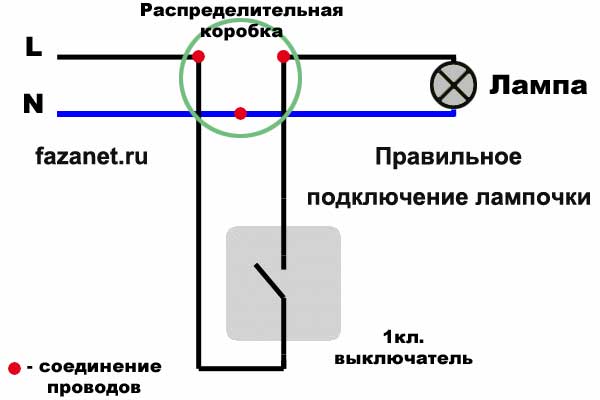
If the connection is incorrect, the glow of the lamps when turned off is simply inevitable. In this case, you need to do correct scheme connection of the lamp.
3. Poor quality of lamps. You can only check by replacing the lamp with another lamp. If the other lamp works normally, then you yourself understand that you need to change the lamp.
Why does the turned on LED lamp blink?
There may also be several cases here.
1. Very strong voltage drops in the network.
It happens that one of the neighbors may work with electric welding or use some other electrical appliances. And if you and this neighbor are on the same phase, then in this case you will have a voltage drop in the network. The lamp, of course, has a special driver to smooth out voltage surges. But if there are strong changes, he may not be able to cope with them.
You can check this by measuring the voltage in the network with a voltmeter. Although, with such power surges, all other electrical appliances will work poorly, and you will immediately notice it.
2. Poor contact in the electrical circuit.
It often happens that when replacing incandescent lamps with LED lamps, they begin to blink. The reason here may be poor contact in the base. This has happened to me many times in practice.
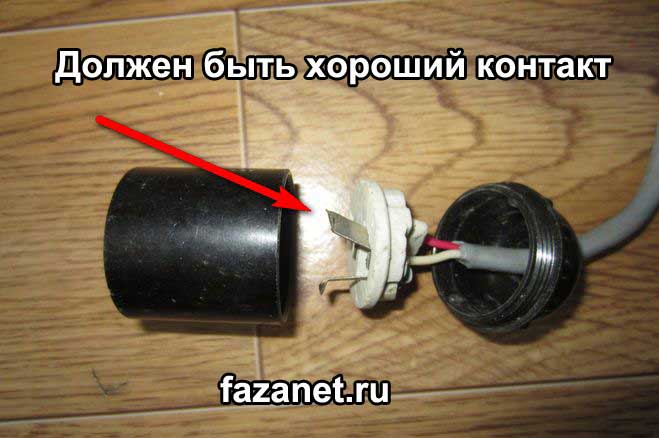
You need to turn off the power to the lamp, unscrew the lamp, and look at the condition of the contacts in the base. The ideal would be to clean them a little and bend them.
3. Some Appliances may be the reason malfunction lamps. If possible, turn them off.
4. Poor quality lamps. If you bought a new lamp, and it flickers, and the problems described above, you do not have. Then go back to the store and ask to exchange it.
5. Another possible option is that the service life has expired. This happened at my home. One lamp simply stopped glowing. If you push it, it can light up and work normally. And when next switch on, again it may not light up or blink.
That's all I wanted to say about the reasons for the blinking of the lamps. If you have questions, ask them in the comments. Click on the buttons social networks and subscribe for updates. Bye.
Sincerely, Alexander!

